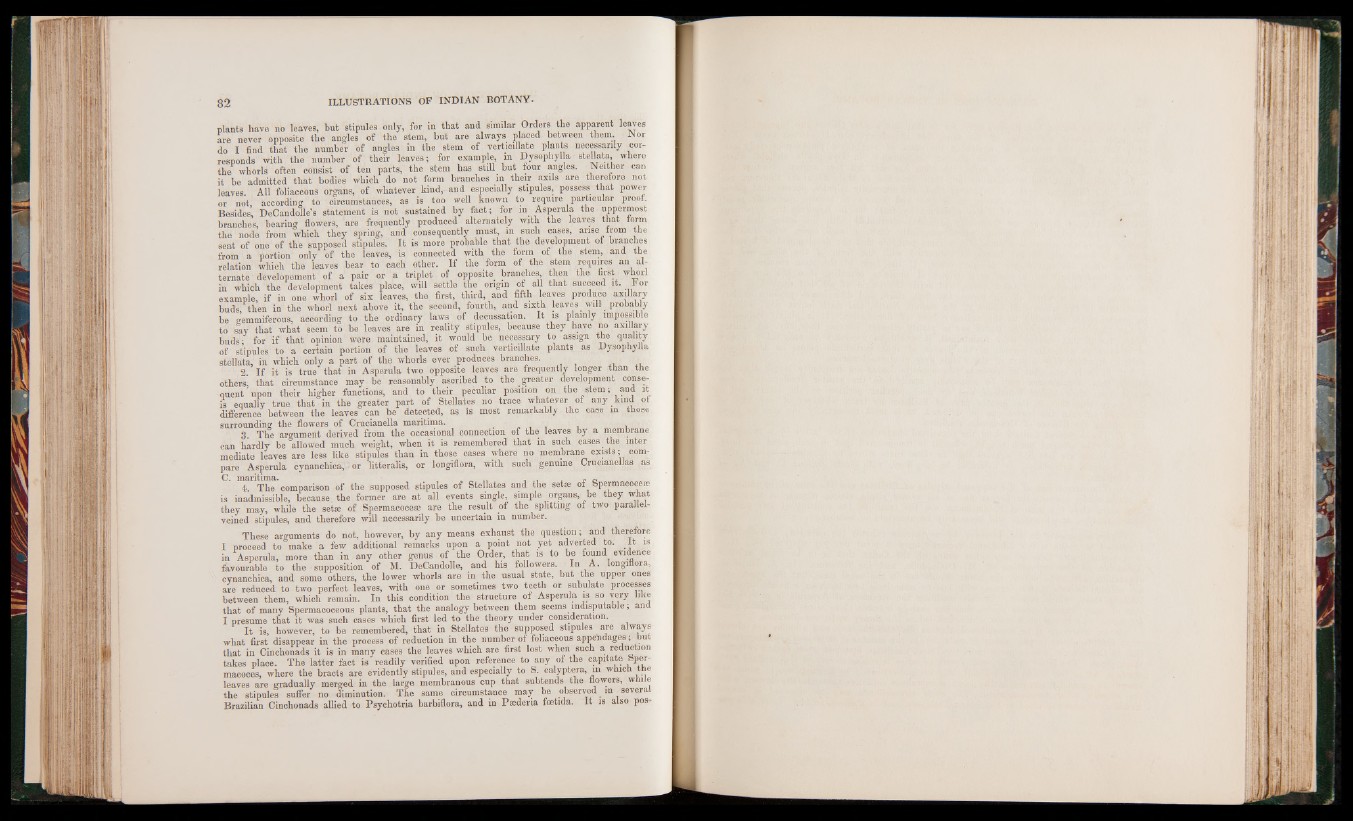
plants have no leaves, but stipules only, for in that and similar Orders the apparent leaves
are never opposite the angles of the stem, but are always placed between them. Nor
do I find that the number of angles in the stem of verticillate plants necessarily corresponds
with the number of their leaves; for example, in Dysophylla stellata, where
the whorls often consist of ten parts, the stem has still but four angles. Neither can
it be admitted that bodies which do not form branches in their axils are therefore not
leaves. All foliaceous organs, of whatever kind, and especially stipules,- possess that power
or not according to circumstances, as is too well known to require particular proof.
Besides, DeCandolle’s statement is not sustained by fact; for in Asperula the uppermost
branches, bearing flowers, are frequently produced alternately with the leaves that form
the node from which they spring, and consequently must, in such cases, arise trom the
seat of one of the supposed stipules. I t is more probable that the development of branches
from a portion only of the leaves, is connected with the form of the stem, and the
relation which the leaves bear to each other. If the form of thé stem requires an alternate
developement of a pair or a triplet of opposite branches, then the first whorl
in which the development takes place, will settle the origin of all that succeed it. F or
example, if in one whorl of six leaves, the first, third, and fifth- leaves produce axillary
buds then in the whorl next above it, the second, fourth, and sixth leaves will probably
be gemmiferous, according to the ordinary laws of decussation. It is plainly impossible
to say that what seem to be leaves are in reality stipules, because they have no axillary
buds- for if that opinion were maintained, it would be necessary to assign the quality
of stipules to a certain portion of the leaves of such verticillate plants, as Dysophylla
stellata, in which only a part of the whorls ever produces branches.
2. If it is true that in Asperula two opposite leaves are frequently longer than the
others, that circumstance may be reasonably ascribed to the greater development consequent
upon their higher functions, and to thfiijL. peculiar position on _ the stem; and it
is equally true that-in the greater part of Stellates no trace whatever of any kind of
difference between the leaves can be detected, as is most remarkably the case in those
surrounding the flowers of CrucianeUa maritima. . i ,
3. The argument derived from the occasional connection of the leaves by a membrane
can hardly be allowed much weight, when it is remembered that in such cases the inter
mediate leaves are less like stipules than in those cases where no membrane exists; compare
Asperula cynanchica,-or litteralis, or longiflora, with such genuine Crucianellas as
C. maritima. g EWMHB SmB I « 0
4. The comparison óf the supposed stipules of Stellates and the setae of Spermacoceae
is inadmissible, because, the former are at all events single, simple organs, be they what
they may, while the setae of Spermacoceae are the result of the splitting of two parallel-
veined stipules, and therefore will necessarily be uncertain in number.
These arguments do not, however, by any means exhaust the question; and therefore
I proceed to make a few additional remarks upon a point not yet adverted to. I t is
in Asperula, more than in any other genus of the Order, that is to be found^ evidence
favourable to the supposition of M. DeCandolle, and his followers. In A. longi ora,
cynanchica, and some others, the lower whorls are in the usual state, but ^the upper ones
are reduced to two perfect leaves, with one or sometimes two teeth or subulate processes
between them, which remain. In this condition the structure of Asperula is so very like
that of many Spermacoceous plants, that the analogy between them seems indisputable; and
I presume that it was such cases which first led to the theory under consideration.
I t is, however, to be remembered, that in Stellates the supposed stipules are a ways
what first disappear in the process of reduction in the number of foliaceous appendages; but
that in Cinchonads it is in many cases the leaves which are first lost when such a reduction
takes place. The latter fact is readily verified upon reference to any of the capitate feper-
macoces, where the bracts are evidently stipules, and especially to S. calyptera, m which the
leaves are gradually merged in the large membranous cup that subtends the flowers, w i e
the stipules suffer no diminution. The same circumstance may be observed in ■ several
Brazilian Cinchonads allied to Psychotria barbiflora, and in Psederia fcetida. It is also pos